Effects of Temperature on the Compressive Strength Parallel to the Grain of Bamboo Scrimbe
Abstract
:1. Introduction
2. Materials and Methods
2.1. Materials
2.2. Specimen Heat Processing
2.3. Mass Loss Test
2.4. Mechanical Test
2.5. FTIR Test
2.6. Statistical Analysis
3. Results and Discussion
3.1. Mass Loss
3.2. Color Changes
3.3. Compressive Analysis
3.4. Changes of Chemical Components
4. Conclusions
- The average compressive strength parallel to the grain of bamboo scrimber was found to be 133 MPa at 20 °C, 61.4 MPa in a designated “during fire” group and 115 MPa in a “post-fire” group at 225 °C. The strength loss of these two groups was 54% and 14%.
- There were significant differences in the compressive properties between the two groups. At one set temperature level, the compressive strength and modulus of elasticity of the “post-fire” group were significantly higher than the ‘during fire’ group, but the ductility coefficient of these two groups was reversed.
- The compressive strength was affected by temperature, but there were other complicating factors at play including moisture content, the adhesive used and raw material.
- Changes in the color of bamboo scrimber occurred in the inner and external areas of the samples after being subjected to high temperature, which became more apparent at temperatures above 150 °C.
- FTIR test results showed that 175 °C was a key turning point, at which the cellulose in the bamboo and the phenolic compounds in the resin thermally decomposed. These results may help to estimate the behavior of bamboo structures during a fire using numerical analysis, to predict the residual load capacity of the material.
Acknowledgments
Author Contributions
Conflicts of Interest
References
- Lakkad, S.C.; Patel, J.M. Mechanical properties of bamboo, a natural composite. Fiber Sci. Technol. 1980, 14, 319–322. [Google Scholar] [CrossRef]
- Amada, S.; Ichikawa, Y.; Munekata, T.; Nagase, Y.; Shimizu, K. Fiber texture and mechanical graded structure of bamboo. Compos. B Eng. 1997, 28, 13–20. [Google Scholar] [CrossRef]
- Yu, Y.L.; Huang, X.N.; Yu, W.J. A novel process to improve yield and mechanical performance of bamboo fiber reinforced composite via mechanical treatments. Compos. B Eng. 2014, 56, 48–53. [Google Scholar] [CrossRef]
- Gerhards, C.C. Effect of moisture content and temperature on the mechanical properties of wood: An analysis of immediate effects. Wood Fiber Sci. 1982, 14, 4–36. [Google Scholar]
- Manríquez, M.J.; Moraes, P.D. Influence of the temperature on the compression strength parallel to grain of paricá. Constr. Build. Mater. 2010, 24, 99–104. [Google Scholar] [CrossRef]
- Moraes, P.D.; Rogaume, Y.; Bocquet, J.F.; Triboulot, P. Influence of temperature on the embedding strength. Holz Roh-Werkst 2005, 63, 297–302. [Google Scholar] [CrossRef]
- Bekhta, P.; Niemz, P. Effect of high temperature on the change in colour, dimensional stability and mechanical properties of spruce wood. Holzforschung 2003, 57, 539–546. [Google Scholar] [CrossRef]
- Green, D.W.; Evans, J.W. Effect of cyclic long-term temperature exposure on the bending strength of lumber. Wood Fiber Sci. 2008, 40, 288–300. [Google Scholar]
- Kocaefe, D.; Poncsak, S.; Boluk, Y. Effect of thermal treatment on the chemical composition and mechanical properties of birch and aspen. BioResources 2008, 3, 517–537. [Google Scholar]
- China Standards Publication. Method for Determination of the Moisture Content of Wood; GB/T 1931; Chinese National Standardization Management Committee: Beijing, China, 2009.
- China Standards Publication. Method of Testing in Compressive Strength Parallel to Grain of Wood; GB/T 1935; Chinese National Standardization Management Committee: Beijing, China, 2009.
- Zhang, Y.M.; Yu, Y.L.; Yu, W.J. Effect of thermal treatment on the physical and mechanical properties of phyllostachys pubescen bamboo. Eur. J. Wood Wood Prod. 2013, 71, 61–67. [Google Scholar] [CrossRef]
- Hakkou, M.; Pétrissans, M.; Zoulalian, A.; Gérardin, P. Investigation of wood wettability changes during thermal treatment on the basis of chemical analysis. Polym. Degrad. Stab. 2005, 89, 1–5. [Google Scholar] [CrossRef]
- Manninen, A.M.; Pasanen, P.; Holopainen, J. Comparing the VOC emissions between air-dried and heat-treated scots pine wood. Atmos. Environ. 2002, 36, 1763–1768. [Google Scholar] [CrossRef]
- Kosikova, B.; Hricovini, M.; Consentino, C. Interaction of lignin and polysaccharides in beech wood (Fagus Silvatica) during drying process. Wood Sci. Technol. 1999, 33, 373–380. [Google Scholar]
- Zhang, Y.M.; Yu, W.J.; Zhang, Y.H. Effect of Steam Heating on the Color and Chemical Properties of Neosinocalamus Affinis Bamboo. J. Wood Chem. Technol. 2013, 33, 235–246. [Google Scholar] [CrossRef]
- Schaffer, E.L. Effect of pyrolytic temperatures on the longitudinal strength of dry douglas fir. J. Test Eval. 1973, 1, 319–329. [Google Scholar]
- Fengel, D.; Wegener, G. Wood Chemistry, Ultrastructure, Reactions; Walter de Gruyter: Berlin, Germany, 1989. [Google Scholar]
- Beall, F.C.; Eickner, H.W. Thermal Degradation of Wood Components; Forest Products Research Paper, FPL 130; USDA Forest Serv.: Madison, WI, USA, 1970.
- Salmen, L. Temperature and Water Induced Softening Behaviour of Wood Fiber Based Material. Ph.D. Thesis, Department of Paper Technology, The Royal Institute of Technology, Stockholm, Sweden, 1982. [Google Scholar]
- Qin, L. Effect of Thermo-Treatment on Physical, Mechanical Properties and Durability of Reconstituted Bamboo Lumber. Ph.D. Thesis, Chinese Academy of Forestry, Beijing, China, 2010. [Google Scholar]
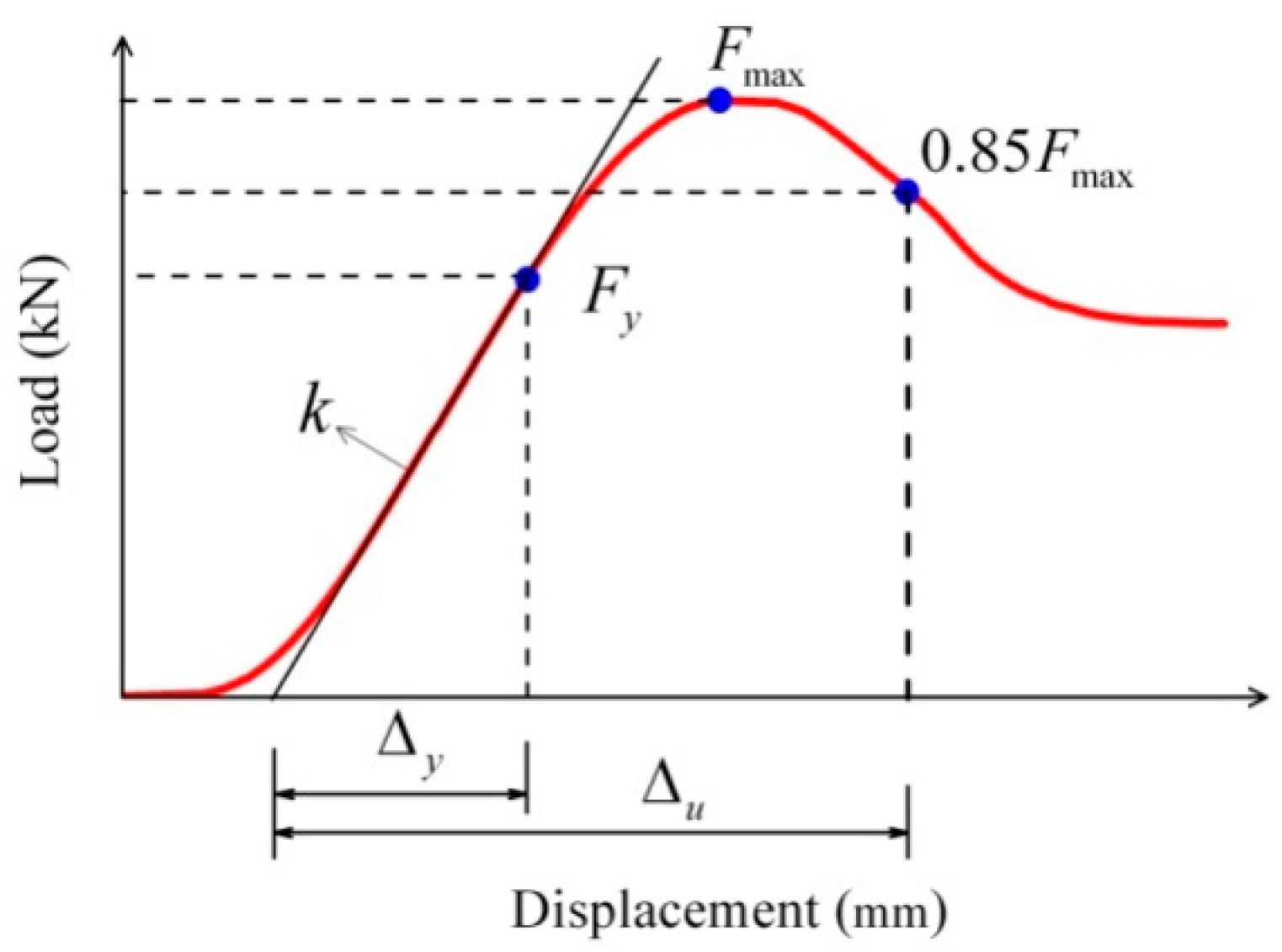


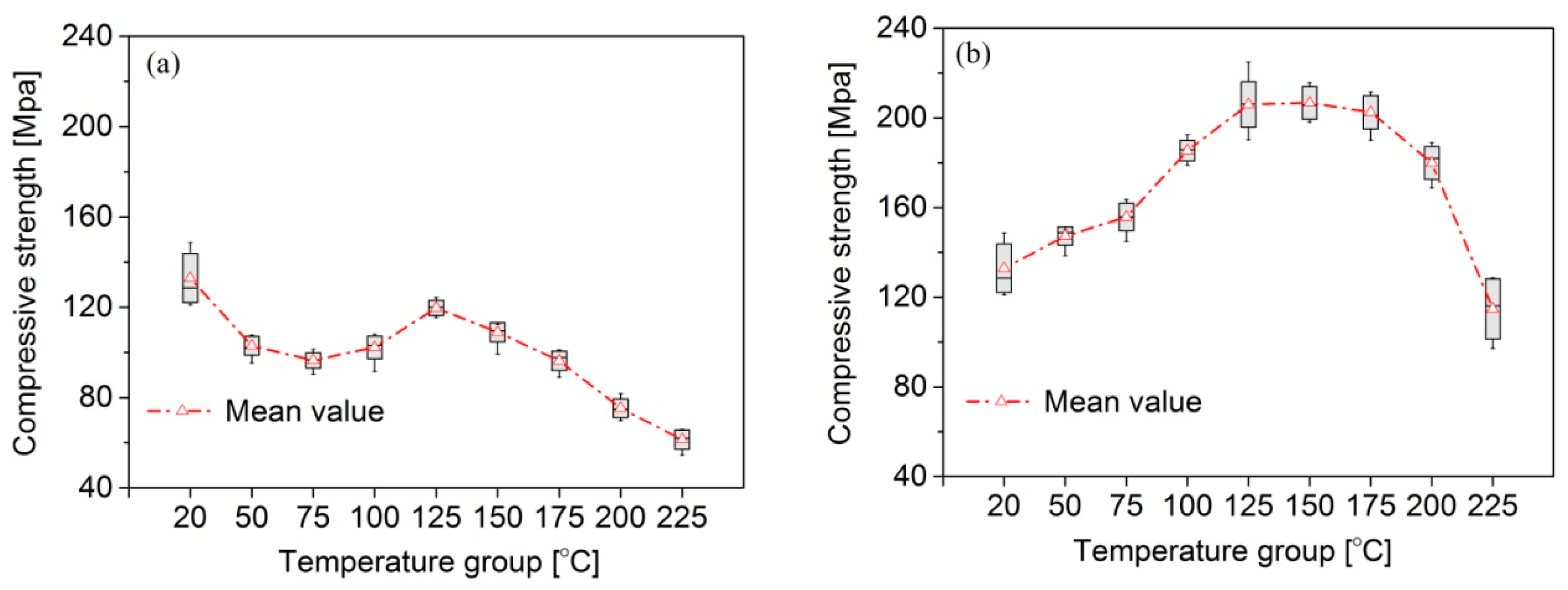
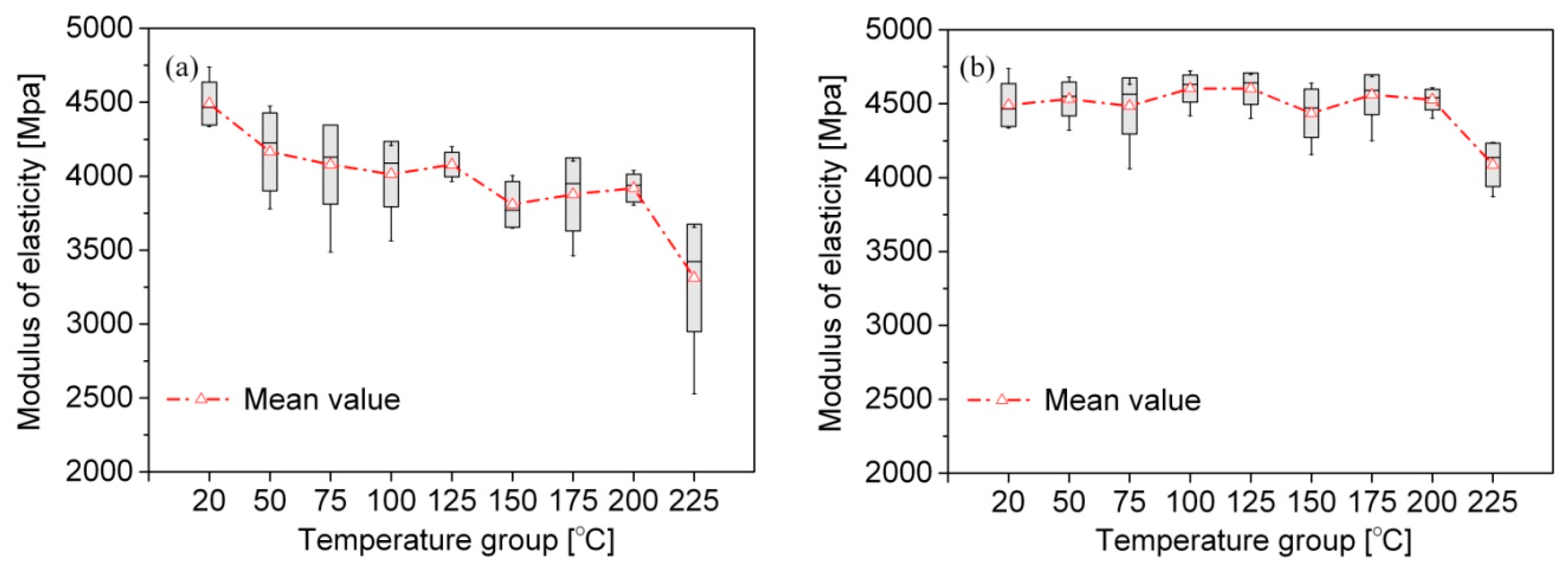
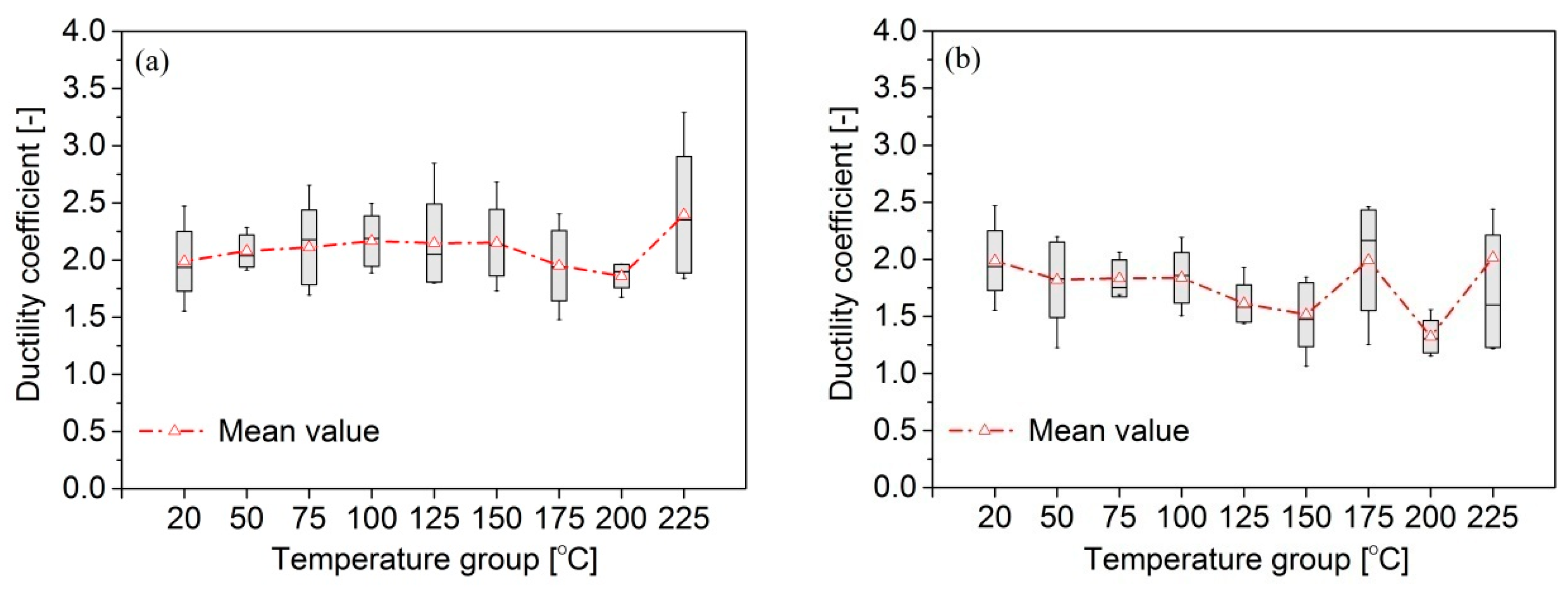
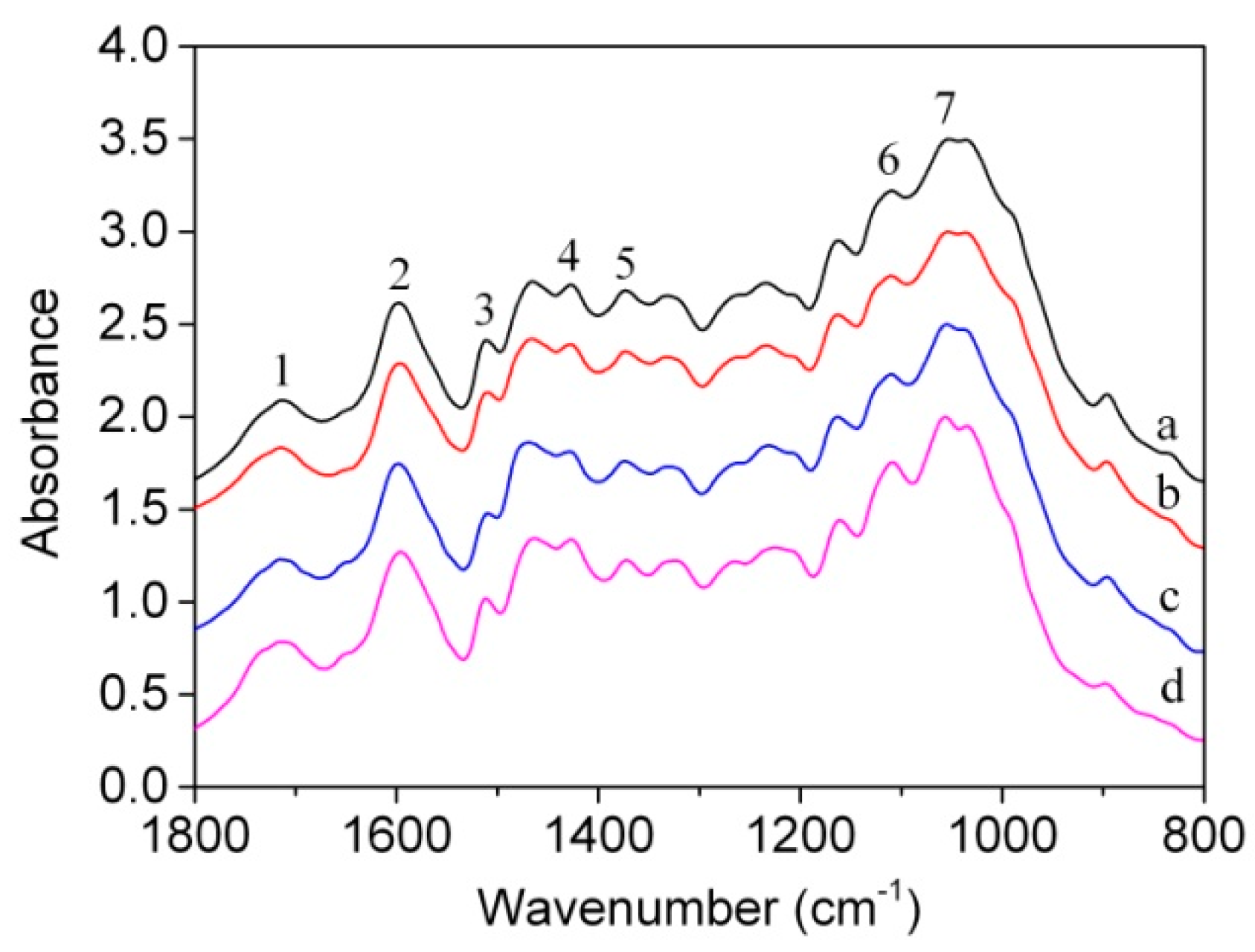
| Temperature (°C) | Number of Specimens | Group A | Group B | ||
|---|---|---|---|---|---|
| Avg (g/cm3) | SD (g/cm3) | Avg (g/cm3) | SD (g/cm3) | ||
| 20 | 10 | 1.117 | 0.071 | - | - |
| 50 | 18 | 1.142 | 0.033 | 1.173 | 0.022 |
| 75 | 18 | 1.167 | 0.041 | 1.151 | 0.052 |
| 100 | 18 | 1.150 | 0.025 | 1.148 | 0.024 |
| 125 | 18 | 1.134 | 0.032 | 1.141 | 0.042 |
| 150 | 18 | 1.143 | 0.036 | 1.169 | 0.042 |
| 175 | 18 | 1.142 | 0.034 | 1.116 | 0.044 |
| 200 | 18 | 1.165 | 0.041 | 1.153 | 0.043 |
| 225 | 18 | 1.144 | 0.037 | 1.119 | 0.061 |
| Total | 152 | ||||
| Heated Temperature (°C) | Group A | Group B | ||||
|---|---|---|---|---|---|---|
| f (MPa) | E (MPa) | μ | f (MPa) | E (MPa) | μ | |
| 20 | 133.0 ± 10.8a | 4492 ± 145a | 1.99 ± 0.26b | 133.0 ± 10.8d | 4492 ± 145ab | 1.99 ± 0.26b |
| 50 | 102.9 ± 4.1d | 4165 ± 264b | 2.08 ± 0.14ab | 147.3 ± 4.1c | 4532 ± 114ab | 1.82 ± 0.33ab |
| 75 | 96.5 ± 3.4e | 4078 ± 268bc | 2.11 ± 0.33ab | 155.8 ± 6.1c | 4484 ± 190ab | 1.83 ± 0.16ab |
| 100 | 102.2 ± 5.0d | 4014 ± 221bcd | 2.17 ± 0.22ab | 185.3 ± 4.6b | 4603 ± 91a | 1.84 ± 0.22ab |
| 125 | 119.7 ± 3.3b | 4078 ± 83bc | 2.15 ± 0.34ab | 206.0 ± 10.1a | 4602 ± 107a | 1.61 ± 0.16bc |
| 150 | 109.0 ± 4.3c | 3810 ± 155d | 2.15 ± 0.29ab | 206.7 ± 7.4a | 4436 ± 163b | 1.52 ± 0.28bc |
| 175 | 96.3 ± 4.3e | 3878 ± 247cd | 1.95 ± 0.31b | 202.5 ± 7.5a | 4561 ± 135ab | 1.99 ± 0.44a |
| 200 | 75.3 ± 4.1f | 3920 ± 94bcd | 1.86 ± 0.10b | 179.9 ± 7.3b | 4528 ± 69ab | 1.32 ± 0.14c |
| 225 | 61.4 ± 4.3g | 3313 ± 363e | 2.40 ± 0.51a | 114. 8 ± 13.4e | 4087 ± 147c | 1.72 ± 0.49ab |
| Number | Wavenumber (cm−1) | Absorption Peak Location and Assignment |
|---|---|---|
| 1 | 1712 | C=O stretching of xylan (hemicelluloses) |
| 2 | 1596 | C=C stretching of benzene ring (phenolic resin) |
| 3 | 1510 | Carbon skeleton stretching of benzene ring (lignin of bamboo) |
| 4 | 1427 | C-H stretching of methlene |
| 5 | 1373 | C-H deforming and stretching (cellulose and hemicelluloses of bamboo) |
| 6 | 1108 | C-H stretching of aromatic ring (phenolic resin) |
| 7 | 1053 | C-O stretching |
| 8 | 897 | Anomeric carbon (C1) stretching (cellulose of bamboo) |
| Temperature (°C) | I1596/I1108 | I897/I1108 |
|---|---|---|
| 20 | 4.98a | 0.93a |
| 125 | 4.95a | 0.84a |
| 175 | 4.41b | 0.61b |
| 225 | 2.92c | 0.25c |
© 2016 by the authors; licensee MDPI, Basel, Switzerland. This article is an open access article distributed under the terms and conditions of the Creative Commons Attribution (CC-BY) license (http://creativecommons.org/licenses/by/4.0/).
Share and Cite
Zhong, Y.; Ren, H.-Q.; Jiang, Z.-H. Effects of Temperature on the Compressive Strength Parallel to the Grain of Bamboo Scrimbe. Materials 2016, 9, 436. https://doi.org/10.3390/ma9060436
Zhong Y, Ren H-Q, Jiang Z-H. Effects of Temperature on the Compressive Strength Parallel to the Grain of Bamboo Scrimbe. Materials. 2016; 9(6):436. https://doi.org/10.3390/ma9060436
Chicago/Turabian StyleZhong, Yong, Hai-Qing Ren, and Ze-Hui Jiang. 2016. "Effects of Temperature on the Compressive Strength Parallel to the Grain of Bamboo Scrimbe" Materials 9, no. 6: 436. https://doi.org/10.3390/ma9060436





